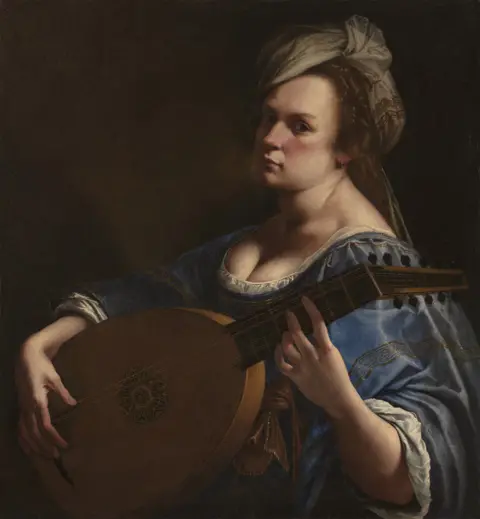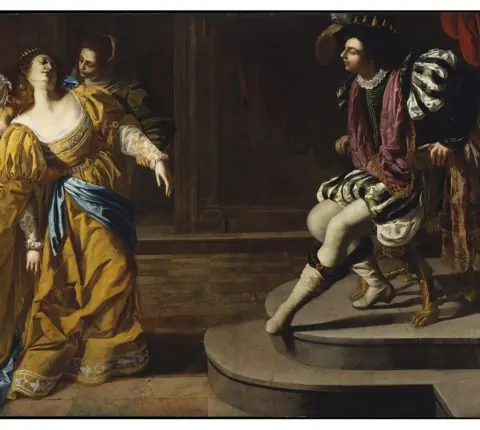Artemisia Gentileschi: Five-star reviews for 'the Beyoncé of art history'
 Wadsworth Atheneum Museum of Art
Wadsworth Atheneum Museum of ArtThe first major UK exhibition of an artist who was overlooked for centuries because of her sex has been hailed as "thrilling" and "magnificent".
The Artemisia Gentileschi exhibition at London's National Gallery is due to open after a six-month Covid-19 delay.
The Italian Baroque artist created vivid images of strong women.
Critics at The Telegraph, The Guardian, The Times and The Evening Standard have all delivered five-star reviews, with the latter calling her "fantastic".
The Guardian's Jonathan Jones described the exhibition as "a thrill ride from beginning to end" and "the most thrilling exhibition I have ever experienced at the National Gallery".
He wrote: "This show is a heroic act of resurrection by curator Letizia Treves, who has managed, in the face of the pandemic, to bring together all of Artemisia's important paintings. We see her entire. It's like being hit by a train."
The Times art critic Rachel Campbell-Johnston wrote: "Printed reproductions cannot prepare you for the dramas into which you are about to plunge.
"Setting out into the territories of the great male masters, Gentileschi approached long-familiar stories from a unique female slant that lends her retelling a peculiarly complex and perturbing force."
 Pinacoteca Nazionale Bologna
Pinacoteca Nazionale Bologna BBC arts editor Will Gompertz was also dazzled: "You leave this excellent show with two questions at the front of your mind: Firstly, has there ever been a better, bolder painter of human drama?
"And secondly, why has it taken so long for her to be given a major exhibition in the UK? It is possible you've never heard of Artemisia Gentileschi, but it is impossible to forget her having seen the National Gallery exhibition."
The Evening Standard's Nancy Durrant wrote: "Artemisia Gentileschi was forgotten about for an awfully long time, and though there's a tiresomely obvious reason for that, looking at these you can't help but think the establishment must have been blind as well as bigoted."
Durrant praised Artemisia's "first, stunning version" of Susanna and the Elders, painted when she was 17, in which "her female bodies, with their warm, softly creasing skin, are the more convincing, possibly because she had one".

Who was Artemisia?
The 17th Century painter is described by the National Gallery as "exceptional - she challenged conventions and defied expectations to become a successful artist and one of the greatest storytellers of her time".
She was born in Rome in 1593, and her father, also a painter, began training her when she was 16.
As a teenager, she underwent torture in court in a judicial attempt to discover whether or not she had been raped. She steadfastly stuck to her account. A friend of her father, Agostino Tassi, was initially found guilty, but his conviction was overturned not long afterwards.
That experience undoubtedly informed some of her later work, including one of her most famous paintings, the brutal Judith Beheading Holofernes.
Shortly after the trial, she married and moved to Florence, joining the city's Academy of Design in 1616, the first woman to do so.
She later spent time in Rome, Naples and Venice before moving with her father to London, where they both worked for Charles I. Her talent was recognised during her lifetime, but was then largely forgotten until the late 20th Century.

 Metropolitan Museum of Art
Metropolitan Museum of ArtAlastair Sooke, writing in The Telegraph, described her as "art history's greatest heroine" and her work as "thrilling".
"There are 2,300 works in the gallery's collection, but only 23 by female artists - including a recently acquired self-portrait by Artemisia. So this show is a way of redressing the balance."
She is "a sort of proto-feminist heroine, the queen bee of female empowerment: the Beyoncé, if you like, of art history", Sooke added.
It is the gallery's first major exhibition devoted to a female historical painter, its director Gabriele Finaldi said.
He said she "comes across as a very powerful and inspirational figure" at the start of the 21st Century.
"In a world of 17th Century art which was dominated by men patrons and men artists, Artemisia found a way to have her own voice heard, to have success and autonomous success on her own, and she achieved that through extraordinary talent, extraordinary invention but also through very clever connections with patrons and with supporters."

Follow us on Facebook, or on Twitter @BBCNewsEnts. If you have a story suggestion email entertainment.news@bbc.co.uk.